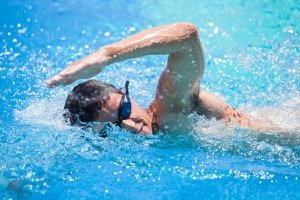Swimming has been described by experts as one of the best therapies for chronic, low back pain. In fact, many research studies have concluded that not only does it significantly reduce pain, but also cuts down the level of stress hormones that your body produces. That is important, as stress often contributes to low back pain. Exercising in water can also help prevent further injury because your back isn’t bearing any weight.
Since it’s is a form of low-impact aerobic exercise, there are many benefits of swimming for pain management. If you suffer from low back pain, or pain and stiffness in other areas, swimming may be just right for you. The buoyancy of the water supports your body’s weight, reducing stress on your joints and spine, and allows for greater range of motion.
Swimming helps because it works to strengthen the muscles that support your neck or back. Therefore, less stress is put on the spinal column and as a result, pain can be overcome. If you can warm up your pool, that promotes blood flow which helps speed up the healing process.
The hydrostatic pressure of water also helps encourage healthy blood flow to the large muscles in the back, and the smaller muscle groups that help support them. At the same time, swimming and other water exercises can strengthen the core muscles as well.
Here’s four benefits of swimming for pain management:
Increased mobility – Because of the water’s natural buoyancy, you are able to twist and turn more freely in water. This allows for a wider range-of-motion exercises that wouldn’t be possible on dry ground.
Natural resistance – If you are used to doing trunk twists on land, but, because of the pain, you aren’t able to; try them in the water. Water is roughly 600 times more resistant than air, so performing these exercises in the pool can be more effective, and not as painful. It can also help you stretch out the back muscles.
Decreased load bearing – If you are dealing with a disc issue that makes movement painful, the water works to remove the stress of gravity from your spine. Because you aren’t concentrating on the pain, your exercises can be more beneficial in healing your back.
No chance of falling – Any type of back pain, injury, or if you are recovering from surgery, can have a negative impact on your balance. A painful nerve, or loss of balance because of a muscle spasm can send you right to the ground. By exercising in the pool, you eliminate the risk of falling. It will also help strengthen the muscles in your feet to improve your balance on dry land as well.
Hawaiian Pool Builders would like to offer some swimming strokes to help:
The best swim strokes to help relieve low back pain should be performed in a vertical or standing position to keep the spine neutral, and avoid hyperextension. Incorporating strokes that exercise the abdominal and hip muscles also improve back health. A strong core is key to maintaining correct posture and a healthy spine.
Water aerobics – If you are recovering from a back injury, water aerobics can help condition your lower back muscles and your core, and can prepare you for more strenuous lap-type swimming. Before you begin a more in-depth water aerobic routine, begin by walking or running in place to get your heart rate up. Take about 10-20 steps forward, and then back. Try to increase your speed to make it more difficult. You can also alternate jogging for 30 seconds with your walking. Do this for about 5-10 minutes.
The friction of the water offers gentle resistance throughout the movements, which builds the muscles around the joints and back. A good program would include a warm-up, cool-down, and flexibility exercises that mimic land exercises, such as dancing and jumping jacks without the high impact.
Sidestroke – This is especially good if you suffer from sciatic nerve pain. A side stroke can best be described as picking apples from a tree, bringing that arm down, and pushing back up again. While you do this, you keep your legs swimming, just as with a typical swim stroke. The sidestroke eliminates any strain on your back, which can help relieve the pain associated with sciatica.
Backstroke – If you suffer from rounded shoulders and/or back pain, try the backstroke. This stroke pulls the shoulders back into proper alignment. It also works to strengthen the lats and upper back. Because of the slight hip rotation, your core is also engaged. Together, these movements work to strengthen the abdominal muscles and provides added support for your spine.
Pull drill – Even though the water’s buoyancy eliminates the stress that is typically absorbed by your joints during exercise, you can still overuse your back muscles during strokes that rotate your body. A pull drill – swimming using only your arms – stretches the lower back muscles without overextending them.
Take long strokes, keeping your legs isolated. Concentrate on elongating your body, and stretching the muscles in your lower back as you swim. Work to keep your balance so that your lower half doesn’t sink, and keep your strokes even on each arm.
Here’s some additional tips to help you get a good program off right:
- Water shoes will help to provide traction on the pool floor.
- Water level can be waist or chest high.
- Use a Styrofoam noodle or floatation belt/vest to keep you afloat in deeper water.
- Slower movements in the water will provide less resistance than faster movements.
- You can use webbed water gloves, Styrofoam weights, inflated balls, or kickboards for increased resistance.
- Never push your body through pain during any exercise.
- Although you will not notice that you sweat with pool exercises, it is still important to drink plenty of water.
Before starting any exercise program, even in your swimming pool, Hawaiian Pool Builders recommends you talk to your health care provider. We want you to feel better and enjoy your water exercises.







